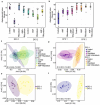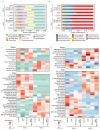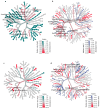Arbuscular Mycorrhizal Fungi and Rhizobium Improve Nutrient Uptake and Microbial Diversity Relative to Dryland Site-Specific Soil Conditions
- PMID: 38674611
- PMCID: PMC11052256
- DOI: 10.3390/microorganisms12040667
Arbuscular Mycorrhizal Fungi and Rhizobium Improve Nutrient Uptake and Microbial Diversity Relative to Dryland Site-Specific Soil Conditions
Abstract
Arbuscular mycorrhizal fungi (AMF) and rhizobium play a significant role in plant symbiosis. However, their influence on the rhizosphere soil microbiome associated with nutrient acquisition and soil health is not well defined in the drylands of Montana (MT), USA. This study investigated the effect of microbial inoculants as seed treatment on pea yield, nutrient uptake, potential microbial functions, and rhizosphere soil microbial communities using high-throughput sequencing of 16S and ITS rRNA genes. The experiment was conducted under two contrasting dryland conditions with four treatments: control, single inoculation with AMF or Rhizobium, and dual inoculations of AMF and Rhizobium (AMF+Rhizobium). Our findings revealed that microbial inoculation efficacy was site-specific. AMF+Rhizobium synergistically increased grain yield at Sidney dryland field site (DFS) 2, while at Froid site, DFS 1, AMF improved plant resilience to acidic soil but contributed a marginal yield under non-nutrient limiting conditions. Across dryland sites, the plants' microbial dependency on AMF+Rhizobium (12%) was higher than single inoculations of AMF (8%) or Rhizobium (4%) alone. Variations in microbial community structure and composition indicate a site-specific response to AMF and AMF+Rhizobium inoculants. Overall, site-specific factors significantly influenced plant nutrient uptake, microbial community dynamics, and functional potential. It underscores the need for tailored management strategies that consider site-specific characteristics to optimize benefits from microbial inoculation.
Keywords: Rhizobium; agroecosystem; arbuscular mycorrhizal fungi (AMF); drylands; field pea; microbial inoculants; microbiome; root symbiosis.
Conflict of interest statement
The authors declare no conflicts of interest. USDA Disclaimer: Mention of trade names or commercial products in this publication is solely for the purpose of providing specific information and does not imply a recommendation or endorsement by the U.S. Department of Agriculture. USDA is an equal opportunity provider and employer.
Figures







References
-
- Food and Agriculture Organization of the United Nation CropWat|Land & Water. 2018. [(accessed on 5 January 2019)]. Available online: http://www.fao.org/land-water/databases-and-software/crop-information/so...
-
- Liebig M.A., Acosta-Martinez V., Archer D.W., Halvorson J.J., Hendrickson J.R., Kronberg S.L., Samson-Liebig S.E., Vetter J.M. Conservation practices induce tradeoffs in soil function: Observations from the northern Great Plains. Soil Sci. Soc. Am. J. 2022;86:1413–1430. doi: 10.1002/saj2.20375. - DOI
-
- Peterson G.A. Reference Module in Earth Systems and Environmental Sciences. Elsevier; Amsterdam, The Netherlands: 2018. Dryland Farming.
-
- FAOSTAT. 2022. [(accessed on 15 February 2024)]. Available online: https://www.fao.org/faostat/en/#data/QCL.
-
- State Agriculture Overview USDA/NASS 2022 State Agriculture Overview for Montana. [(accessed on 14 February 2022)];2022 Available online: https://www.nass.usda.gov/Quick_Stats/Ag_Overview/stateOverview.php?stat....
Grants and funding
LinkOut - more resources
Full Text Sources

